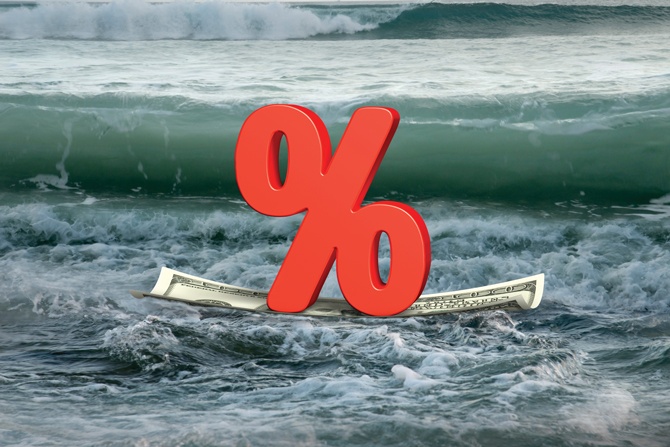If you are a commercial or agribusiness lender, it’s likely been a while since you had a significant number of defaults in your portfolio. I wish I could tell you it’s because your borrowers are all financially healthy and operationally disciplined. Unfortunately, borrower distress and problem loans have not been eradicated from commercial and agribusiness lending. They’ve just become much harder to diagnose.
A much better explanation for the lack of defaults is that a decade-long bull market and historically low-interest rates drove up asset values and created a lot of investor-class wealth. This, in turn, caused a massive influx of private money into the financial system, increasing competition among lenders and shifting the balance of power in favor of borrowers. Eventually, even small- and middle-market businesses found themselves able to borrow more than they ever had before. And borrow they did, with many of these businesses using their increased liquidity for controlled, sustainable growth. Many others, however, used it to cover up the effects of their poor business decisions, personal misfortunes and even fraud.
When the bull market ended in March 2020, it briefly seemed like the jig was up – that borrowers secretly in distress would finally be unmasked. But then, an unprecedented amount of government financial assistance in response to the COVID pandemic was indiscriminately doled out to good and bad businesses alike. The market rebounded and thereafter has remained robust. In short, the jig was not up, there was no unmasking, and to this day, many unprofitable and overleveraged borrowers continue to look from the outside like good businesses with low risks of default.
Now I could tell you a down-cycle is imminent – that it’s only a matter of time before you start seeing a sharp increase in defaults as a result of supply chain disruption, interest rate hikes and growing inflation driving up the cost of doing business. But frankly, no one can say with any certainty when the next downturn will happen. Plus, I bet by now someone like me has been telling you “this is the year the music will finally stop” for at least five years running, and you’re understandably sick of hearing it.
Instead, let’s assume the music keeps playing for a while, and as long as it does, the default rate in your loan portfolio remains very low. This period – from today until the next wave of defaults finally arrives – presents a golden opportunity for you to nip potential problem loans in the bud before they cause you actual problems. The challenge, however, is determining which among all the performing loans in your portfolio should be labeled as “problems” and given your attention. Because of high liquidity levels and greatly appreciated asset values, historical indicators of distress such as payment defaults and blown leverage ratios can no longer be relied on as early warning systems. Without new, more effective strategies for identifying those borrowers most likely to default, commercial and agribusiness lenders are taking on materially greater risk than you were ten, five or even two years ago.
Here are five strategies you can use to effectively mitigate this additional hidden credit risk:
- Take advantage of available opportunities to enhance collectability.
To state the obvious, it’s not a viable lending practice to start requiring additional credit support from borrowers at a time when they are making all required payments and have not triggered serious non-payment defaults. So your best opportunity to identify problem loans and enhance their collectability comes when borrowers request their existing loans be extended, rolled over or consolidated with new extensions of credit. Too many lenders agree to these requests in exchange for little or nothing in return, even though most borrowers would be willing to grant concessions under these circumstances. These opportunities are the doorway to implementing other enhancements discussed below. - Look for signals of distress in non-obvious places.
You don’t have to rely on the borrower to give you the information you need. You may be surprised what people make publicly available about themselves, their friends and family members. Investigate and see if you come across anything worth asking the borrower about (e.g., pictures posted on social media showing the borrower driving around town in his new sports car the same day he asked you for a loan extension). Also, if you have access to the borrower’s bank statements (e.g., under a deposit account control agreement), have someone review the borrower’s recent cash flow activity. In addition to helpful information about the borrower’s business relationships and spending priorities with other creditors, you may find undisclosed assets, new business ventures or even evidence of fraud. For example, in a recent lender engagement, I discovered the borrower, who had been in default and not paid my client for several years, had entered into an undisclosed land sale contract that he was using to siphon off and hide my client’s cash collateral. Reviewing the borrower’s account statements, I noticed small but frequent payments over the last few years, all going to one individual (a relative of the borrower). Upon further investigation, that individual turned out to be the record owner of farmland he was “selling” to the borrower in exchange for payments that should have been used to repay my client. If that had been one of your borrowers and even assuming he was current on his payments, would you agree to roll over his loan? To lend him additional money. - Enhance collectability by fixing mistakes in the original loan documents.
Take the time to have someone carefully go over the original loan documents and check for any mistakes or omissions, whether any assumptions made when the loan was originated need adjustment, and whether you continue to have valid, perfected security interests in all of your original collateral. Then ask the borrower to agree to any amendments needed to correct or adjust the original loan documents. Because these enhancements merely ensure the original intent of the parties is realized, an honest borrower should not push back on this request. - Enhance collectability by securing additional new collateral.
This isn’t a novel concept, although lenders already using this strategy don’t always benefit from traditional grants of additional collateral (e.g., taking a second lien in assets that would fail to produce enough proceeds to pay off the first lien in an enforcement scenario). Lenders should think “outside the box” when requesting additional collateral. Try requesting a lien in an asset of particular importance to a borrower requesting a rollover or extension, even though the asset itself may have little or no liquidation value in your hands (e.g., trademark and brand assets in a borrower’s pet project). Remember, borrowers can only lose assets they pledged as collateral if they are unable or unwilling to fulfill their contractual obligations. If you ask for more collateral and a borrower pushes back too hard, it may mean the rollover or extension they requested involves greater credit risk than you thought before you asked. Finally, those who lend to businesses entitled to receive government assistance payments may be able to take a lien in those payments under certain circumstances. For example, a lender to a farmer receiving federal farm program payments may collect those payments if the farmer previously assigned them to the lender as collateral by executing the proper Farm Service Agency paperwork. - Explore and exploit opportunities to sell loans to distressed investors.
Too many banks and traditional lenders ignore opportunities to get rid of “problem” loans until it is too late. Today’s secondary market is saturated with private capital providers looking to invest in distressed situations of virtually all sizes and risk levels. Typically, these investors provide additional rescue financing and turnaround expertise that original lenders can’t or won’t provide, with an expectation the borrower will return to financial health and payoff both the rescue financing and existing loan in full. As a result, these investors will often purchase existing loans for a price near or even above the returns originating lenders would realistically collect if they retained and worked the loans themselves. Crucially, however, originating lenders’ opportunities to find buyers at these price points comes before a borrower’s distress has been compounded. Lenders who mindlessly roll over and consolidate their own positions until their borrowers are completely out of cash flow and unencumbered assets and have no clear paths to rehabilitation cannot then go to the secondary market and expect to find a buyer for their position.
Unprecedented liquidity and asset appreciation may have pushed the day of reckoning for distressed borrowers off into the future, but it is saddling commercial and agribusiness lenders with additional credit risk now. Start using these strategies today to mitigate that risk by identifying which of your borrowers may be in distress and maximizing the collectability of your potential problem loans.
Jeremy C. Hollembeak is an experienced financial restructuring and workout attorney at Baird Holm LLP in Omaha, Nebraska. He concentrates his practice on distressed investment opportunities and related litigation. Jeremy regularly negotiates debt purchase, refinancing and rescue financing transactions. He advises on disputes arising in distressed situations, developing and executing strategies to protect and enforce contract and collateral rights and collect on money judgments. His clients include banks, private capital providers, strategic investment funds and litigation funders.










